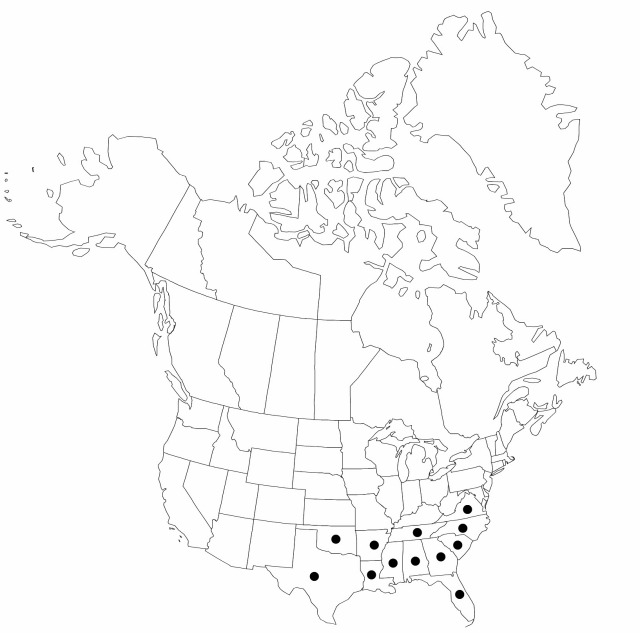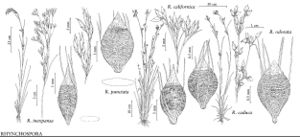Difference between revisions of "Rhynchospora caduca"
Sketch Bot. S. Carolina 1: 62. 1816.
FNA>Volume Importer |
FNA>Volume Importer |
||
| Line 11: | Line 11: | ||
|name=Phaeocephalum caducum | |name=Phaeocephalum caducum | ||
|authority=(Elliott) House | |authority=(Elliott) House | ||
| − | }}{{Treatment/ID/Synonym | + | }} {{Treatment/ID/Synonym |
|name=Rhynchospora patula | |name=Rhynchospora patula | ||
|authority=A. Gray | |authority=A. Gray | ||
| Line 29: | Line 29: | ||
|elevation=0–400 m | |elevation=0–400 m | ||
|distribution=Ala.;Ark.;Fla.;Ga.;La.;Miss.;N.C.;Okla.;S.C.;Tenn.;Tex.;Va. | |distribution=Ala.;Ark.;Fla.;Ga.;La.;Miss.;N.C.;Okla.;S.C.;Tenn.;Tex.;Va. | ||
| − | |discussion=<p>Rhynchospora caduca has its closest relationships with the even more robust R. odorata Grisebach, on the one hand, and the swampinhabiting, more slender, and rhizomatous R. mixta Britton ex Small, on the other. Intergrades with R. odorata appear in Alabama and northwest Florida; intergrades with R. mixta appear where ranges overlap in both the Atlantic and Gulf coastal plains.</p> | + | |discussion=<p><i>Rhynchospora caduca</i> has its closest relationships with the even more robust <i>R. odorata</i> Grisebach, on the one hand, and the swampinhabiting, more slender, and rhizomatous <i>R. mixta</i> Britton ex Small, on the other. Intergrades with <i>R. odorata</i> appear in Alabama and northwest Florida; intergrades with <i>R. mixta</i> appear where ranges overlap in both the Atlantic and Gulf coastal plains.</p> |
|tables= | |tables= | ||
|references= | |references= | ||
| Line 53: | Line 53: | ||
|publication year=1816 | |publication year=1816 | ||
|special status= | |special status= | ||
| − | |source xml=https://jpend@bitbucket.org/aafc-mbb/fna-data-curation.git/src/ | + | |source xml=https://jpend@bitbucket.org/aafc-mbb/fna-data-curation.git/src/8f726806613d60c220dc4493de13607dd3150896/coarse_grained_fna_xml/V23/V23_390.xml |
|genus=Rhynchospora | |genus=Rhynchospora | ||
|species=Rhynchospora caduca | |species=Rhynchospora caduca | ||
Revision as of 16:07, 18 September 2019
Plants perennial, cespitose, 70–150 cm; rhizomes often present, short, scaly. Culms erect or ascending, leafy, trigonous. Leaves exceeded by culm; blades linear, proximally 4–7 mm wide, apex trigonous, tapering. Inflorescences terminal and axillary; clusters 3–6, mostly dense, narrowly to broadly turbinate, branches ascending; leafy bracts exceeeding proximalmost inflorescences. Spikelets rich brown, ovoid, (3–)4–5 mm, apex acuminate; fertile scales ovate, 2.5–3.5 mm, apex acuminate, midrib included or shortexcurrent. Flowers: perianth bristles mostly 6, exceeding tubercle tip. Fruits mostly 3–4 per spikelet, 2–2.2 mm; body brown on short pedicellar (to 0.3 mm) stalk, broadly obovoid, lenticular, 1.3–1.5 × 1–1.5 mm, surfaces transversely rugulose, vertically finely striate and rectangularalveolate; tubercle compressed, triangular acuminate, 0.5–0.8 mm, edges setulose.
Phenology: Fruiting summer–fall.
Habitat: Low meadows, clearings, marshes, marsh borders, seeps, bog moats, savannas, ditches, pine flatwoods, swamps
Elevation: 0–400 m
Distribution

Ala., Ark., Fla., Ga., La., Miss., N.C., Okla., S.C., Tenn., Tex., Va.
Discussion
Rhynchospora caduca has its closest relationships with the even more robust R. odorata Grisebach, on the one hand, and the swampinhabiting, more slender, and rhizomatous R. mixta Britton ex Small, on the other. Intergrades with R. odorata appear in Alabama and northwest Florida; intergrades with R. mixta appear where ranges overlap in both the Atlantic and Gulf coastal plains.
Selected References
None.
